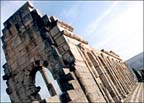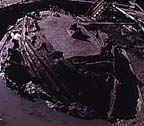"A Dallas archaeologist and his field crew have unearthed a treasure more than 2 millennia old gold, silver and bronze artifacts at an Etruscan settlement in Italy. But the scientists are more excited about ruined buildings and walls than they are about the precious metals. The site, called Poggio Colla, is revealing what ordinary life was like for the Etruscans, the builders of Italy's first cities. "
"Poggio Colla spans most of Etruscan history, from roughly 750 B.C. to 150 B.C. The site is unusual because it reveals Etruscan civic life and because it is found so far north."
Subsection of Roman Times:
Articles about current archaeology and research into the remains of Roman and Byzantine civilizations.
Thursday, December 18, 2003
Wednesday, December 17, 2003
Britain and Morocco reach conservation agreement for Volubilius
 I see that Britain and Morocco have reached a conservation agreement for the ancient Roman site of Volubilius in Morocco.
I see that Britain and Morocco have reached a conservation agreement for the ancient Roman site of Volubilius in Morocco.
“Volubilis was a Roman settlement constructed on what was probably a Carthaginian city, dating from 3rd century BC. Volubilis was a central administrative city responsible for grain production in this fertile region, and exports to Rome. Volubilis was also administering contacts with the Berber tribes which the Romans never managed to suppress, but who only came as far as to cooperate with the Romans for mutual benefits.�
This website has some nice pictures of the site including two of the thirty mosaics uncovered there. The basilica was also very interesting.
Monday, December 15, 2003
Romans: The Original Effects Artists
 "The Colosseum in Rome was as sophisticated as a modern stage set, according to archaeologists who have calculated how an intricate system of gangplanks, trapdoors and levers was used to bring wild animals into the arena."
"The Colosseum in Rome was as sophisticated as a modern stage set, according to archaeologists who have calculated how an intricate system of gangplanks, trapdoors and levers was used to bring wild animals into the arena."
"We found the Romans invested an enormous amount of energy in making their games ever more spectacular," said Heinz-Juergen Beste. "We had to do a lot of research to recreate this stage. What we found was an extremely sophisticated system."
By measuring the floor space and cavities in the walls where wooden lifts, levers and cages would have been constructed, and comparing their findings with contemporary accounts of how animals "magically appeared", the archaeologists have pieced together how the mechanisms worked.
"We can tell that two or three different mechanical systems were installed. We have found more than 28 lifts used to get animals into the Colosseum. With a pull of a lever they could send scenery, artificial forests or castles made of papier-mache into the arena. The animals were taken down into the basement where they were put into cages.
"From there they were hauled up to a second level, and the door to the cages opened. The beasts would then run up ramps and out into the arena."
Thursday, December 11, 2003
Fragments of Roman Wine Amphora Found in Site of Ancient Indian Port
"Southampton varsity scholar Roberta Tomber claims that the pottery pieces found by K P Shajan, a marine geologist, from Pattanam near Paravoor, are parts of Roman wine amphora, Mesopotamian torpedo jar and Yemenite storage jar. 'It is the first time that we have found evidence in Malabar coast. The clay is very different from what was used in India during the same period. A lot of black minerals are present,' she says. "
If this claim is true, then the pieces are the first evidence of Roman pottery to be found in Kerala. It also strengthens the theory that the port of Muziris was in the belt of Kodungallur-Chettuva.
"These were found in Pattanam, north of Paravoor. The whole area is strewn with pottery samples. Though many of them are of Indian origin, a few pieces of Indo-Roman era were also found. A detail exploration of the area will alone help establish this fact," Shajan, who chanced upon the evidence during a geological survey, said.
If this claim is true, then the pieces are the first evidence of Roman pottery to be found in Kerala. It also strengthens the theory that the port of Muziris was in the belt of Kodungallur-Chettuva.
"These were found in Pattanam, north of Paravoor. The whole area is strewn with pottery samples. Though many of them are of Indian origin, a few pieces of Indo-Roman era were also found. A detail exploration of the area will alone help establish this fact," Shajan, who chanced upon the evidence during a geological survey, said.
Tuesday, December 09, 2003
Ancient Bronze Age Chariot Points to Early European Trade
 Archaeologists have discovered a “rare and nationally significant� Iron Age chariot buried for 2,500 years near West Yorkshire. The find is a complete chariot containing the skeleton of a tribal leader, with the remains of at least 250 cattle, probably slaughtered for the funeral feast. Chariot burial at the time – between 500BC and 400BC – was reserved for high-ranking figures from a tribe a tribe known as the Arras, who came to England from France.
Archaeologists have discovered a “rare and nationally significant� Iron Age chariot buried for 2,500 years near West Yorkshire. The find is a complete chariot containing the skeleton of a tribal leader, with the remains of at least 250 cattle, probably slaughtered for the funeral feast. Chariot burial at the time – between 500BC and 400BC – was reserved for high-ranking figures from a tribe a tribe known as the Arras, who came to England from France.
Oxford archaeologists said: “Insights gained from this latest discovery will make a significant addition to our understanding of the burial rites of the period, and help us to understand a wide range of other elements of cultural exchange, including aspects of social reproduction and cross-Channel contact and communication.�
Ghost fleet found at Pisa to be housed in new museum
 "The chance discovery of a Roman 'ghost fleet' buried in mud just outside Pisa has led experts to conclude that the city was built on a lagoon much like an early Venice. Archaeologists believe that traces of a community dating back to a pre-Roman era, a sort of 'Etruscan Venice', may lie beneath the ships."
"The chance discovery of a Roman 'ghost fleet' buried in mud just outside Pisa has led experts to conclude that the city was built on a lagoon much like an early Venice. Archaeologists believe that traces of a community dating back to a pre-Roman era, a sort of 'Etruscan Venice', may lie beneath the ships."
"The find first came to light five years ago when a bulldozer involved in work to build railway offices beside the San Rossore station on the outskirts of Pisa came across an ancient wooden ship 30ft below ground. A large archaeological dig which was started under Prof Bruni's direction later found four ships dating from various Roman periods. The number of vessels, which were found in remarkable condition, rose to six, then nine, and finally 21, including what experts believe may be a Roman warship. They date from 200BC-AD500."
"The ships will soon be housed in a new museum in Pisa's old shipyards, Giuliano Urbani, Italy's culture minister, announced last week. "It will not just be a building," he said. "It will also be a kind of historical space which will develop in tandem with the stages of recovery and restoration of the ships."
Friday, December 05, 2003
Lost Worlds: When the Romans Ruled Africa
Australians will be able to watch a new French documentary about excavations now underway in Tunisia. Hopefully, it will find its way to the BBC and the Discovery or History Channels for those of us in the US.
"French and Tunisian archaeologists are excavating a Roman-era necropolis in modern-day Hammamet, in north Africa. For five centuries, Tunisia was part of the Roman empire. Those buried or burnt here were mostly ordinary people.
Perhaps they worked on the many Roman buildings that dot the countryside. Their tombs are humble: babies buried in amphorae, a woman burnt with a mirror and necklace, and, everywhere, oil lamps and pottery dishes left from the families' last meal with the dead.
Were they Africans who had become Romanised, or vice-versa?"
"French and Tunisian archaeologists are excavating a Roman-era necropolis in modern-day Hammamet, in north Africa. For five centuries, Tunisia was part of the Roman empire. Those buried or burnt here were mostly ordinary people.
Perhaps they worked on the many Roman buildings that dot the countryside. Their tombs are humble: babies buried in amphorae, a woman burnt with a mirror and necklace, and, everywhere, oil lamps and pottery dishes left from the families' last meal with the dead.
Were they Africans who had become Romanised, or vice-versa?"
ABC to tackle "Empire" series
"ABC has greenlit production on the eight-hour project Empire, an epic take on the fate of the Roman Empire."
"The project, which had been developed under the working title 'Tyrannus,' follows the story of Julius Caesar's nephew Octavius, who battles general Marc Antony for control of Rome after Caesar is assassinated. Octavius finds an ally in Tyrannus - the gladiator assigned to protect him - and eventually becomes the emperor Augustus."
"The project, which had been developed under the working title 'Tyrannus,' follows the story of Julius Caesar's nephew Octavius, who battles general Marc Antony for control of Rome after Caesar is assassinated. Octavius finds an ally in Tyrannus - the gladiator assigned to protect him - and eventually becomes the emperor Augustus."
Thursday, December 04, 2003
Michael Apted to direct "Rome"
"Michael Apted ('The World Is Not Enough,' 'Coal Miner's Daughter') has signed on to direct the first three episodes of 'Rome,' an HBO series set in the time of Caesar and the rise of the Roman Empire. The series, a co-production of HBO and the BBC, is scheduled for a 2005 premiere.
The series, which is set to begin filming in March, will chronicle the lives of two Roman soldiers and their families. HBO calls it 'an intimate drama' set against the epic backdrop of the Rome circa 51 BC."
The series, which is set to begin filming in March, will chronicle the lives of two Roman soldiers and their families. HBO calls it 'an intimate drama' set against the epic backdrop of the Rome circa 51 BC."
Tuesday, December 02, 2003
Roman Baths in the City of Bath
A nice comprehensive site on the Roman Baths of Bath and the current development of a modern bathing complex.
Subscribe to:
Posts (Atom)